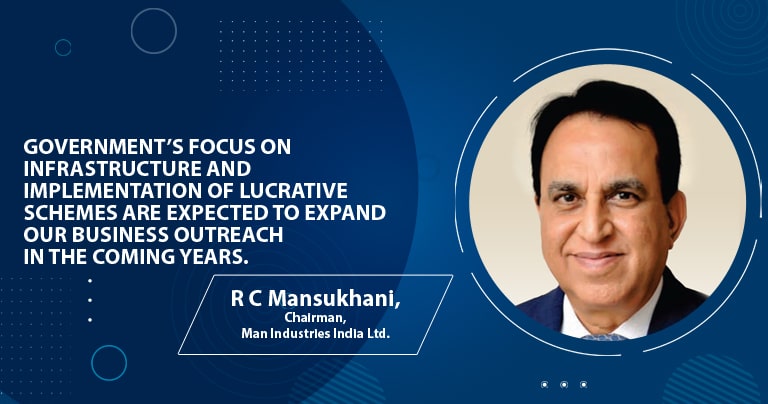Increasing infra projects will fuel the demand for steel pipes
By Edit Team | December 8, 2021 4:54 pm SHARE

R C Mansukhani, Chairman, Man Industries India Ltd. in an interview with B2B Purchase.
How is the global infrastructure of industry trends impacting the demand for pipes in the Indian market?
We, at Man Industries, are more inclined to manufacture pipes for the oil and gas sector, and our products are used worldwide. Unfortunately, during the COVID-19 pandemic in 2020, oil prices were significantly reduced. But today, if you look closely at the oil pricing, they cost between $65 and $80. This is the price at which all the manufacturers wish to install the pipelines for the transformation of the oil and gas industry. In the last eight months, we have observed a steep increase in gas prices, which is helping the industry. Hence, the CAPEX is going to increase for all the hydrocarbon sector products, which will further boost the growth of the steel pipe sector in domestic and international market.
With growing urbanization, how do you evaluate the growth prospects for steel pipes in Indian industries?
We are present in a very niche and specified sector of steel pipes. For us, the oil and gas sector is a major demand driver as we are one of the key players in the segment. Almost 50% of our business is targeted towards the export and the remaining 50 percent caters to the domestic market’s demand. We have noticed that the usage of normal pipes for water transportation depends upon the government’s budget. Although a government scheme like “Nal se Jal” is a lucrative scheme, it is still at the nascent stage and is yet to attract enough attention for a take-off.
How are fluctuating steel prices impacting the quality and productivity of efficient pipes?
The steel prices barely impacted our business in the beginning and now it’s a path through. However, with regards to the overall industry, the rising steel prices are not favorable for the infrastructure sector, where the government is the buyer and does the protection, and ultimately they end up paying more than the private sector. Since a lot of infrastructure projects are coming in, the government should not add any protection, any non-tariff barriers, instead, they should encourage and reduce duty and check the domestic pricing, which can help all infrastructure projects. Although the global steel prices have been reduced by roughly $150, its impact is yet to be witnessed in the Indian market.
What are the challenges being faced while catering to the demand for infra projects?
I think the allocation of funds, timely project completion and delivery are the most important factors in the oil & gas sector. However, at times, few projects get delayed due to the dearth of skilled and professional contractors, which is also one of the major challenges of the oil & gas industry.
What are your business plans and projections for the coming years?
We at Man Industries are certain that we will cater 80-85 percent of our total services to the oil and gas and hydrocarbon sector and the remaining 15-20 percent will be targeted to water, sewage treatment, and other non-critical sectors. Besides, we are installing the ERW plant to cater to city gas distribution (CGD) infrastructure which is ERW API, and it is coming up to a cost approx. of `175 crores. This project is under implementation and we will get the result in the next six months of its production, which is going to help niche sector API requirement of the city gas distribution.
Cookie Consent
We use cookies to personalize your experience. By continuing to visit this website you agree to our Terms & Conditions, Privacy Policy and Cookie Policy.




































-20240213125207.png)

























